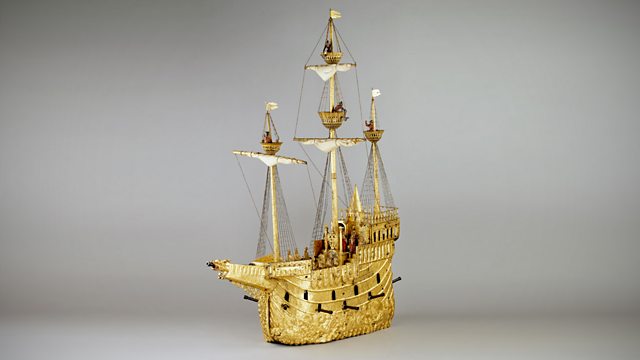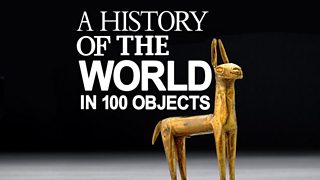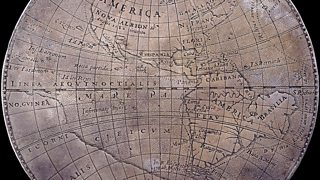The mechanical galleon
Neil MacGregor's world history explores the impact of the great age of European discovery between 1450 and 1600. Today he is with a magnificent clockwork galleon.
Neil MacGregor's world history as told through things. This week he is exploring the impact of Western European travel, trade and conquest between 1450 and 1600. He kicks off with an exquisite miniature version of the sort of high tech vessel that was to take Europeans right around the world. Today's object is a small clockwork version of the type of galleon that the Spanish sent against England in the Armada and that they sent across the high seas. This one was made for a grand dinner table - it could move, make music, tell the time and fire tiny cannons. Neil discusses the significance of this new breed of sailing ships and describes the political state that this galleon symbolises - the Holy Roman Empire. The marine archaeologist Christopher Dobbs compares the tiny galleon to the Mary Rose in Portsmouth and the historian Lisa Jardine considers the European fascination with mechanics and technology throughout the 16th Century.
Producer: Anthony Denselow
Music research specifically for the Akan drum: Michael Doran
Last on
More episodes
Previous
You are at the first episode
![]()
A History of the World in 100 Objects - objects related to money, trade and travel.
About this object
Location: Augsburg, Germany
Culture: European
Period: AD 1585
Material: Metal
��
This mechanical galleon is in fact an elaborate, automated clock. Its mechanism no longer works but originally it would have played music, fired its cannons and trundled across the table at imperial banquets. Clocks like this were important status symbols in the courts of Europe in the 1500s and this clock is based on the great European ships that sailed the oceans during this period. It is unlikely that the clock's creator, Hans Schlottheim in inland Germany, ever saw an actual galleon.
Who is the figure in the throne?
The Holy Roman Emperor is the central figure on this galleon. He is surrounded by seven noblemen known as the Electors, who were responsible for selecting the emperor. When the galleon was made the Holy Roman Emperor was Rudolf II, a member of the powerful Hapsburg family. A galleon was an appropriate symbol for the emperor's power as much of the Hapsburgs' wealth came from silver brought back from the Americas. Mechanical automata were often used as diplomatic gifts and the Hapsburgs gave clocks to the Turkish sultan to maintain peaceful relationships throughout the 1500s.
Did you know?
- The maker of this galleon also made two mechanical crayfish that moved, one of which still exists today in Dresden.
The space shuttle of its day
By Lisa Jardine, Professor of Renaissance Studies, Queen Mary, University of London
��
It’s hard for us to remember that until you can measure time accurately you can’t travel safely. It has to do with, of course, finding your position using navigational instruments, but let’s just leave it at that. You cannot move around the globe safely until you have a clock as well as a compass and the two together are what opens up the globe to European navigators. The Portuguese, the Spanish, the Dutch, the English in the middle to late sixteenth century, so that by the 1580s when England is awaiting the arrival of the Spanish Armada, huge ships moving in every direction across the seas are the sign of global domination; they are the beginnings of Imperialism.
Let me put it this way, if you are on a ship and you leave the port of Bristol and you want to head west wards, you have to hug a coast line if you are to sail in safety, or at least only move out to the sea to a distance from which you can see the coast line, unless you have technological navigational instruments. You can only enter into open sea, in other words, move towards America , go round the cape to the spice islands, if you have accurate clocks, measuring instruments, depth finding instruments and compasses.
One reason why technology moves forward so fast in the sixteenth century is that it becomes extremely fashionable; the rich, the wealthy of all kinds, the aristocracy, everybody wants to own a bit of technology, something with cogs and wheels and winding bits, a clock, a very ornamental clock, or a very ornamental position finding instrument, jewelled, gilded, they survive and you can see them in our museums. It was fashionable to own scientific instruments because they were the means of expansion, discovery: fortune making. It was the instruments that allowed people to sail out to new lands and speculate in what they found there, so I think that technology and speculation go together, technology and greed, and expansionism and imperialism and speculation go together.
The consequence of this greedy approach, that I think is to some extent sponsored by new technology, is a spiritual hesitation about whether mankind is really allowed to do this. So you get two sides of the coin, you get the exuberant expansion, getting and grabbing and invading and pillaging and bringing back gold and coffee and spices and so on. You also get quite a lot of endowing, of convents and monasteries and so on across Europe with that wealth because the wealthy feel that there has to be some antidote to that.
How does it work?
By David Thompson, curator, British Museum
��
Hans Schlottheim, the Augsburg clockmaker (about 1544 - 1625) was the ingenious creator of a number of sophisticated automata, including the ‘Trumpeter’ made for Wilhelm V Duke of Bavaria, the ‘Tower of Babel’ and the amazing pair of moving crayfish, one of which survives in the Mathmatisch-Physikalischer Salon in Dresden.
He perhaps excelled himself with the creation of a series of automated ‘nefs’ or medieval galleons. Of the three that survive, one is in the Kunsthistorisches Museum in Vienna, one in the Musée de la Renaissance in Écouen, and this one has been in the British Museum since 1866.
The British Museum nef has three separate, spring-driven clockwork mechanisms. One to drive the ship along the table, one is a quarter-striking clock which also operates the procession of Electors, and the third mechanism plays an organ and operates a drumming mechanism.
The nef is designed to run along a table to announce the banquet. It comes from an era when such automated machines were the height of fashion in the royal courts of Rudolf II in the Holy Roman Empire and of Suleiman the Magnificent, ruler of the Ottoman Empire in North Africa and the Middle East.
In static use, the nef has a clock furnished with an elaborately enamelled silver dial with two hands to show the hours and quarters. In the crows’ nests of the main mast, two sailors strike the hours and quarters and the clock also activates the procession of Electors of the Holy Roman Empire, each wearing the scarlet and ermine robe of office and carrying his insignia. Preceded by three heralds clothed in tabards sporting the double-headed eagle, the Electors each turn and bow as they pass the Emperor seated on the throne beneath a canopy at the front of the rear deck.
In performance, the nef would trundle along the table on wheels mounted eccentrically on their axles to give it a pitching motion. As it moved, the miniature organ (regal) played a trumpet tune and there would have been drumming on a drum-skin stretched across the base of the hull. On the main deck there were trumpeters and drummers who moved in time to the music (sadly these have been removed and replaced with figures copied from an original from the rear deck).
As the machine came to the end of its performance the wheel-lock cannon in the bowsprit was automatically fired and this in turn lit a fuse which burned around the hull igniting the other cannons producing loud bangs and much smoke.
Such a spectacular piece would have been the envy of all those illustrious guests invited to a grand banquet hosted by an Elector. It was a wildly expensive entertainment, a rich and lavish display of wealth, and a magical experience for all this who witnessed its performance.
As it was in the 1580s, this wonderful machine is still an object which fascinates us today.
Transcript
Broadcasts
- Mon 20 Sep 2010 09:45�鶹������ҳ��� Radio 4 FM
- Mon 20 Sep 2010 19:45�鶹������ҳ��� Radio 4 FM
- Tue 21 Sep 2010 00:30�鶹������ҳ��� Radio 4
- Mon 16 Aug 2021 13:45�鶹������ҳ��� Radio 4 FM
Featured in...
![]()
Money, Trade and Travel—A History of the World in 100 Objects
A History of the World in 100 Objects - objects related to money, trade and travel.
![]()
Shakespeare - Striking Musical Clock
Shakespeare - Musical clock by Nicholas Vallin
![]()
Shakespeare - Model of a bewitched ship
Shakespeare - Model of a bewitched ship
Podcast
-
![]()
A History of the World in 100 Objects
Director of the British Museum, Neil MacGregor, retells humanity's history through objects






